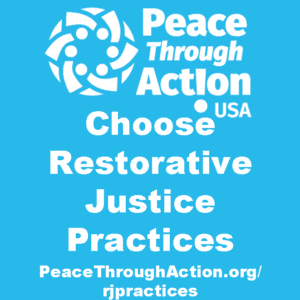What are Restorative Justice Practices?
Restorative justice practices are alternative methods used to address crimes, negative behaviors, or conflicts instead of punishment. They bring together the offender, the victim, and members of a community group to address the issue. These methods seek to hold the offender accountable and work toward rehabilitation instead of punishment while also meeting the needs of the victim.[1]
Restorative justice practices draw from practices by ancient and indigenous peoples worldwide.[2] Restorative justice was introduced into contemporary criminal justice in the 1970s to provide mediation or reconciliation opportunities between victims and offenders.[3] The first reported uses include a probation officer arranging a meeting between teenagers and the victims of their vandalism spree to decide on restitution.
[1]Development Services Group, Inc. 2010. “Restorative Justice.” Literature review. Washington, D.C.: Office of Juvenile Justice and Delinquency Prevention. https://www.ojjdp.gov/mpg/litreviews/Restorative_Justice.pdf
[2] Ibid
[3]Wachtel, T. (2016). History. Defining restorative. International Institute for Restorative Practices. https://www.iirp.edu/defining-restorative/history
How do people learn Restorative Justice Practices?
Restorative justice practices can be learned by individuals for use in individual classrooms or they can be learned by schools, communities, or justice organizations to put into practice in their communities. There are several organizations geared toward teaching restorative justice practices. The International Institute for Restorative Practices (IIRP) offers graduate programs and continuing education programs for individuals. The Center for Restorative Process offers training for groups to implement their program in schools or communities. Their training is focused on five core concepts they have developed around restorative circles.
How do people implement Restorative Justice Practices?
Restorative justice practices can be used in school, community, and carceral settings to address undesirable behavior. In schools they are used to reduce suspensions and expulsions thus reducing the number of students missing education time. Restorative justice practices shift the focus from suppression and exclusion to recognizing opportunities for social and emotional growth and reparation of relationships.[1]
In communities restorative justice practices can be used to address crime. They address the root causes of crime instead of focusing on punishment and perpetuating the cycle. By repairing the harm done to the victim and addressing root causes restorative justice practices provide opportunities for transformation in the victim, the perpetrator, and the community.[2]
Restorative justice practices can also be used in prisons to aid rehabilitation and ease the transition by a former offender back into their community. The practices can include classes in yoga, mindfulness, and on violence prevention.[3] As highlighted by the Restorative Justice Exchange, this path can create transformation within the offenders and victims that can lead to the “root causes of crime, even systemic and structural issues.” And addressing these systemic issues can “foster more just systems and healthier, safer communities.”[4]
[1] “What is Restorative Justice? What are Restorative Practices?” Center for Restorative Process. Retrieved June 7, 2022, from: http://www.centerforrestorativeprocess.com/restorative-justice-and-restorative-practices.html
[2] Three Core Elements of Restorative Justice (n.d.) Restorative Justice Exchange. Retrieved June 7, 2022, from: https://restorativejustice.org/what-is-restorative-justice/three-core-elements-of-restorative-justice/
[3] Suttie, J. (2015, June 9). Can Restorative Justice Help Prisoners to Heal? Greater Good Magazine. Retrieved on June 15, 2022, from https://greatergood.berkeley.edu/article/item/restorative_justice_help_prisoners_heal.
[4] Ibid
For what types of circumstances are Restorative Justice Practices suited?
Restorative justice practices are well suited for repairing the long-term harm that results from aggression and violence. They are also well suited for interrupting aggression and violence between people and groups.
Do Restorative Justice Practices work for preventing or controlling aggression or violence?
IIRP finds that restorative justice has a positive effect on community health by “increas[ing] people’s personal and collective efficacy.” They go one to say “[t]hese positive outcomes influence sense of community” and that “[p]eople with greater sense of community are more likely to act in healthy ways and work with others to promote well-being for all.”[1]
Restorative justice practices can lead to higher victim satisfaction and a reduction in the likelihood of reoffending. When used in a school setting it can reduce suspensions and expulsions therefore reducing student disengagement which often leads to risky behaviors including drug and alcohol use and violence.[2]
[1]Community Health & Restorative Practices (n.d.) International Institute for Restorative Practices. Retrieved on June 13, 2022, from: https://www.iirp.edu/resources/community-health-restorative-practices
[2] Restorative Practices: Fostering Healthy Relationships and Promoting Positive Discipline in Schools A Guide for Educators (2014, March). The Schott Foundation. Retrieved on June 7, 2020, from: http://schottfoundation.org/sites/default/files/restorative-practices-guide.pdf
Where else might I go to learn more about Restorative Justice Practices?
- International Institute for Restorative Practices, https://www.iirp.edu/
- US Department of Justice Office of Juvenile Justice and Delinquency Prevention, https://ojjdp.ojp.gov/model-programs-guide/literature-reviews/restorative-justice-for-juveniles#4
- Restorative Justice Exchange, https://restorativejustice.org/
- Center for Restorative Process, http://www.centerforrestorativeprocess.com/
- Peace Through Action Film Event and Discussion on Restorative Justice
Information Sheet-Choose-Restorative Justice Practices (PDF)
Page Author: Amy Neal (volunteer)
Have a suggested improvement to this information sheet? Send it to inbox@peacethroughaction.org
Do Something Right Away to Increase Peace
Subscribe to our YouTube channel
Give a gift of money to support our mission delivery activities
Choose opportunities to take part in our #PeaceBeginsWithWe campaign

